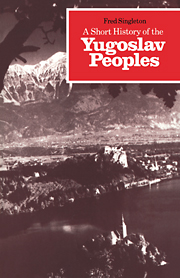Book contents
- Frontmatter
- Contents
- List of tables
- List of maps
- Preface
- Guide to pronunciation
- 1 The lands of the South Slavs
- 2 The early Slav settlers
- 3 The early Slav kingdoms
- 4 The South Slavs under foreign rule
- 5 The development of independence
- 6 The First World War
- 7 The kingdom of Serbs, Croats and Slovenes
- 8 The kingdom of Yugoslavia
- 9 Yugoslavia and the Second World War
- 10 The transition to socialism
- 11 The beginnings of self-management
- 12 The 1960s – a decade of reform
- 13 Tito's last ten years
- 14 Yugoslavia after Tito
- Bibliography
- Index
10 - The transition to socialism
Published online by Cambridge University Press: 20 February 2010
- Frontmatter
- Contents
- List of tables
- List of maps
- Preface
- Guide to pronunciation
- 1 The lands of the South Slavs
- 2 The early Slav settlers
- 3 The early Slav kingdoms
- 4 The South Slavs under foreign rule
- 5 The development of independence
- 6 The First World War
- 7 The kingdom of Serbs, Croats and Slovenes
- 8 The kingdom of Yugoslavia
- 9 Yugoslavia and the Second World War
- 10 The transition to socialism
- 11 The beginnings of self-management
- 12 The 1960s – a decade of reform
- 13 Tito's last ten years
- 14 Yugoslavia after Tito
- Bibliography
- Index
Summary
The Tito–Šubasić government which came into existence in March 1945 was intended to be a caretaker administration, set up to govern the country during the difficult period of post-war reconstruction. It was, in reality, the National Liberation Committee plus three former ministers of the royal government in exile. A provisional Assembly of 318 members replaced AVNOJ in August 1945. It included 80 non-communists, some representing the pre-war political parties, but the overwhelming majority of members were supporters of the Communist Party and former participants in AVNOJ. In order not to disturb relations with the western Allies, a neutral title was used, which begged the question as to whether the new Yugoslavia was to be a republic or a monarchy. Elections to a Constituent Assembly were called in the name of Democratic Federative Yugoslavia (Demokratska Federativna Jugoslavia), and a single list of candidates who supported the newly formed People's Front was presented to the voters on 11 November.
Some of the pre-war politicians intended to contest the elections and an attempt was made to form a United Democratic coalition to oppose the People's Front list. Milan Grol, leader of the Democratic Party, resigned from the government on 18 August and joined forces with Miša Trifunović of the Radical Party, who had served as premier of the London government for a few weeks in 1943. Šutej and Šubašić resigned at the beginning of October and tried to form a Croat peasant group to collaborate with the Democrats, but they eventually gave up the unequal struggle against the all-powerful People's Front and advised their supporters to boycott the elections.
- Type
- Chapter
- Information
- A Short History of the Yugoslav Peoples , pp. 207 - 226Publisher: Cambridge University PressPrint publication year: 1985



